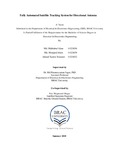| dc.contributor.advisor | Sagor, Md Hasanuzzaman | |
| dc.contributor.author | Alam, Md. Mahbubul | |
| dc.contributor.author | Islam, Md. Monjurul | |
| dc.contributor.author | Mansoor, Ahmad Tamim | |
| dc.date.accessioned | 2018-12-02T10:37:22Z | |
| dc.date.available | 2018-12-02T10:37:22Z | |
| dc.date.issued | 2018 | |
| dc.identifier.other | ID 14321036 | |
| dc.identifier.other | ID 14321039 | |
| dc.identifier.other | ID 14321032 | |
| dc.identifier.uri | http://hdl.handle.net/10361/10932 | |
| dc.description | This thesis is submitted in partial fulfilment of the requirements for the degree of Bachelor of Science in Electrical and Electronic Engineering, 2018. | en_US |
| dc.description | Catalogued from PDF version of thesis. | |
| dc.description | Includes bibliographical references( page 58-60). | |
| dc.description.abstract | When a Low Orbiting Cube satellite passes over a location it can receive and transmit HF/UHF frequency in a directional radiation. We get maximum efficiency when the satellite and the GS’s antenna stays in straight direction. Here we developed a low cost, dependable and efficient satellite tracking system. This system is able to move GS’s directional antenna precisely to maintain a straight-line direction with the targeted satellite throughout the whole pass. The tracking system divided into rotator and control box part. For rotator system we use DC motor for both azimuthal and elevation rotation. The motor have high torque with low RPM to rotate the rotator at precise angle. Controller box is interfaced with CPU such a way that it automatically collect the azimuth and elevation value from CPU and according to the data it will run the gear system. The CPU run algorithm to calculate the present position of the targeted satellite from updated TLE. A feedback system read the position of rotor by using voltage dividing rule and compare the real position with expected position. According the available data, controller box calculate and fix antenna’s elevation & azimuth precisely. The control box continue the process again and again throughout the whole pass. That is how satellite and GS’s antenna able to maintain a straight direction. The designed system is be able to carry different gain antenna in same antenna tower. Which reduce the space demand for tower installation and increase the efficiency. The designed system is so universal that user can modify the rotator system according to their weight demand. The controller box for the specific rotator is designed by using Atmega 2560, Cytron MD10C, BOURNS 3590 and B10K potentiometer. Through this designed satellite tracking system user will be able to track & operate mission both manually and automatically, when satellite will pass over ground station. This design also increase the chance to install automatic data collection center at remote area and help to gather more field data for further research. | en_US |
| dc.description.statementofresponsibility | Md. Mahbubul Alam | |
| dc.description.statementofresponsibility | Md. Monjurul Islam | |
| dc.description.statementofresponsibility | Ahmad Tamim Mansoor | |
| dc.format.extent | 63 pages | |
| dc.language.iso | en | en_US |
| dc.publisher | BRAC University | en_US |
| dc.rights | BRAC University theses are protected by copyright. They may be viewed from this source for any purpose, but reproduction or distribution in any format is prohibited without written permission. | |
| dc.subject | Satellite tracking system | en_US |
| dc.subject | Antenna | en_US |
| dc.subject | Satellite | en_US |
| dc.subject.lcsh | Radio -- Antennas | |
| dc.subject.lcsh | Artificial satellites -- Tracking | |
| dc.title | Fully automated satellite tracking system for directional antenna | en_US |
| dc.type | Thesis | en_US |
| dc.contributor.department | Department of Electrical and Electronic Engineering, BRAC University | |
| dc.description.degree | B. Electrical and Electronic Engineering | |

